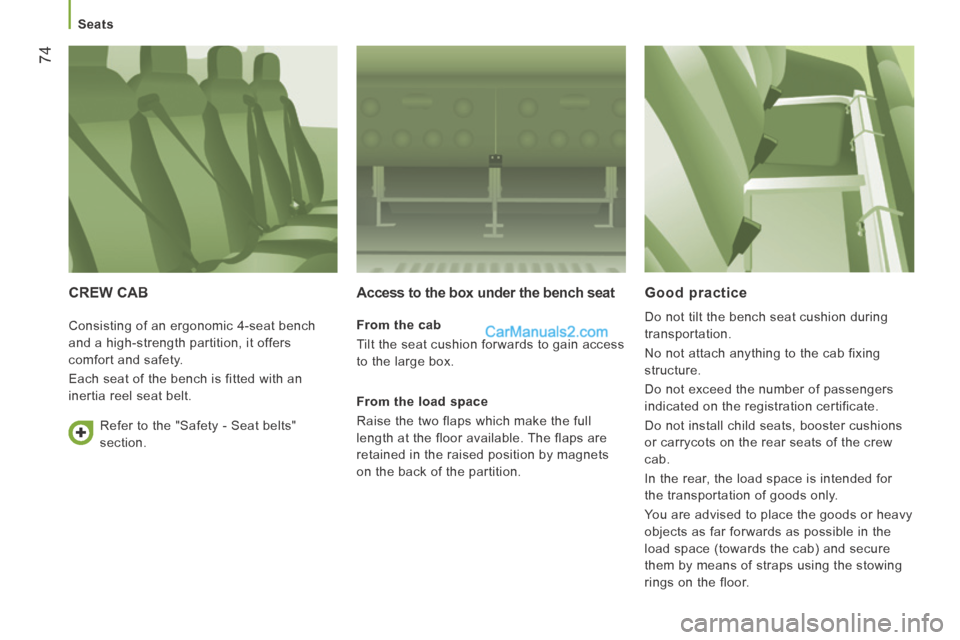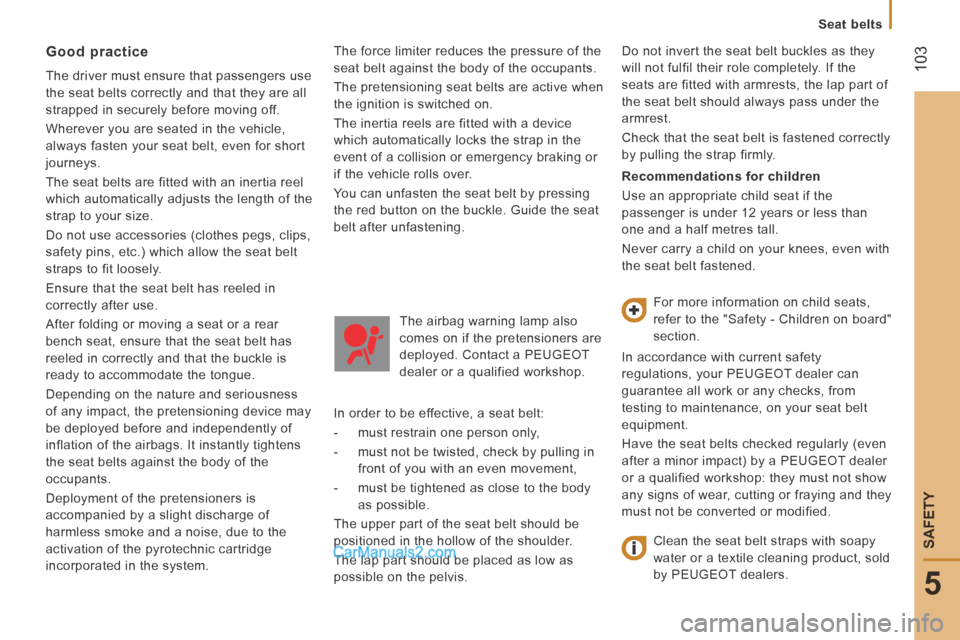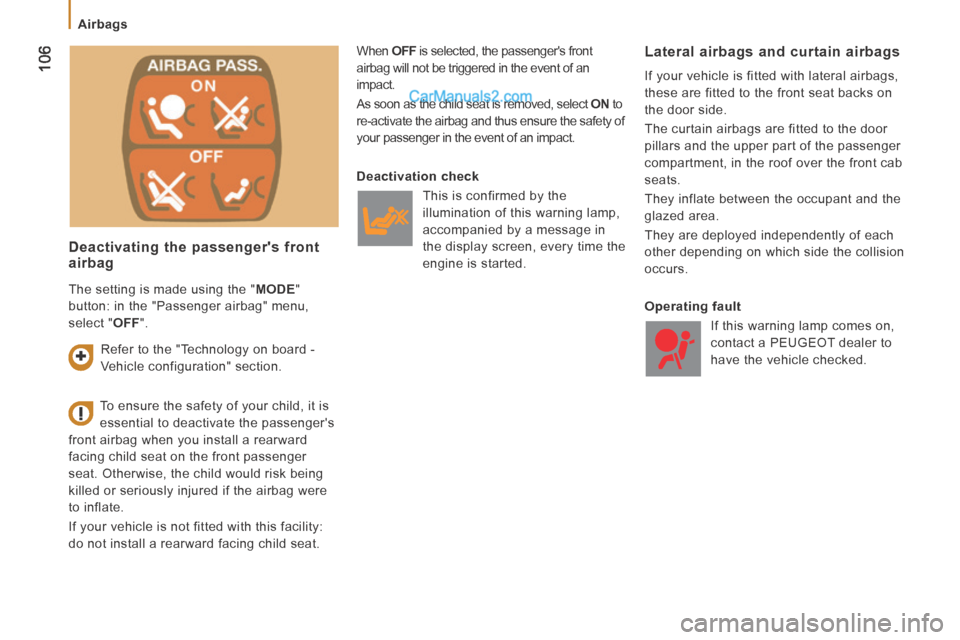2014 Peugeot Boxer child seat
[x] Cancel search: child seatPage 5 of 240

3
Contents
CONTENTS
5. SAFETY 95-1156. ACCESSORIES 116-120
7. CHECKS 121-130
8. QUICK HELP 131-151
9. TECHNICAL D ATA 152-164D ATA 152-164D ATA
Parking brake 95Hazard warning lamps 95Horn 96Braking assistance systems 96Trajectory control systems 98Lane departure warning system 101Seat belts 102Airbags 105Deactivating the passenger's front airbag 106Child seats 108ISOFIX seats 112
Towing a trailer 116Roof carrying systems 118Other accessories 119Snow chains 120
Opening the bonnet 122Under the bonnet 123Levels 124Checks 126Fuel 129
Battery 131Changing a fuse 134Changing a bulb 138Changing a wiper blade 144Changing a wheel 145Puncture repair kit 148Towing the vehicle 150
Dimensions 152Engines 159Weights 160Identifi cation markings 163
10. AUDIO EQUIPMENT and TELEMATICS
TOUCH SCREEN AUDIO-TELEMATIC system 10.1AUDIO system 10.51
Child seats in the rear.
Page 11 of 240

1
AT A GLANCE
9
Location
Seat belts 102-103
Airbags 105-107
Deactivating the passenger's
front airbag 106, 109
Parking brake,
handbrake 95
Front seats, adjustments 69-70
Seat with variable damping 70
2-seat bench 71
Tools, jack 75, 145 Child seats
108-111, 114-115
Rear view mirror
82
Lane departure warning system 101
Cab courtesy lamp 78-79, 141
Changing a courtesy lamp bulb 141
Courtesy lamps 78-79, 141
12 volt socket 77 Battery (+), charging, starting 131-133
Earth point (-)
123, 131
Fuses in the right hand
door pillar 134, 136
INTERIOR
Load space 80-81
● stowing rings,
● load retainer,
● roof box,
● trims,
● 12 volt socket,
● courtesy lamp,
● inspection lamp.
Seats /
rear bench seats
72-73
Rear heating /
air conditioning 64-65
Reversing camera 92
Sliding side door
20
Sliding side windows 81 ISOFIX mountings 112-113
Crew cab 74
Accessories 119
Page 76 of 240

Seats
74
CREW CAB Access to the box under the bench seat
From the cab
Tilt the seat cushion forwards to gain access
to the large box.
From the load space
Raise the two flaps which make the full
length at the floor available. The flaps are
retained in the raised position by magnets
on the back of the partition.
Good practice
Do not tilt the bench seat cushion during
transportation.
No not attach anything to the cab fixing
structure.
Do not exceed the number of passengers
indicated on the registration certificate.
Do not install child seats, booster cushions
or carrycots on the rear seats of the crew
cab.
In the rear, the load space is intended for
the transportation of goods only.
You are advised to place the goods or heavy
objects as far forwards as possible in the
load space (towards the cab) and secure
them by means of straps using the stowing
rings on the floor.
Consisting of an ergonomic 4-seat bench
and a high-strength partition, it offers
comfort and safety.
Each seat of the bench is fitted with an
inertia reel seat belt.
Refer to the "Safety - Seat belts"
section.
Page 105 of 240

103
5
SAFETY
Seat belts
The force limiter reduces the pressure of the
seat belt against the body of the occupants.
The pretensioning seat belts are active when
the ignition is switched on.
The inertia reels are fitted with a device
which automatically locks the strap in the
event of a collision or emergency braking or
if the vehicle rolls over.
You can unfasten the seat belt by pressing
the red button on the buckle. Guide the seat
belt after unfastening. Good practice
The driver must ensure that passengers use
the seat belts correctly and that they are all
strapped in securely before moving off.
Wherever you are seated in the vehicle,
always fasten your seat belt, even for short
journeys.
The seat belts are fitted with an inertia reel
which automatically adjusts the length of the
strap to your size.
Do not use accessories (clothes pegs, clips,
safety pins, etc.) which allow the seat belt
straps to fit loosely.
Ensure that the seat belt has reeled in
correctly after use.
After folding or moving a seat or a rear
bench seat, ensure that the seat belt has
reeled in correctly and that the buckle is
ready to accommodate the tongue.
Depending on the nature and seriousness
of any impact, the pretensioning device may
be deployed before and independently of
inflation of the airbags. It instantly tightens
the seat belts against the body of the
occupants.
Deployment of the pretensioners is
accompanied by a slight discharge of
harmless smoke and a noise, due to the
activation of the pyrotechnic cartridge
incorporated in the system. The airbag warning lamp also
comes on if the pretensioners are
deployed. Contact a PEUGEOT
dealer or a qualified workshop.
In order to be effective, a seat belt:
- must restrain one person only,
- must not be twisted, check by pulling in front of you with an even movement,
- must be tightened as close to the body as possible.
The upper part of the seat belt should be
positioned in the hollow of the shoulder.
The lap part should be placed as low as
possible on the pelvis. Do not invert the seat belt buckles as they
will not fulfil their role completely. If the
seats are fitted with armrests, the lap part of
the seat belt should always pass under the
armrest.
Check that the seat belt is fastened correctly
by pulling the strap firmly.
Recommendations for children
Use an appropriate child seat if the
passenger is under 12 years or less than
one and a half metres tall.
Never carry a child on your knees, even with
the seat belt fastened.
For more information on child seats,
refer to the "Safety - Children on board"
section.
In accordance with current safety
regulations, your PEUGEOT dealer can
guarantee all work or any checks, from
testing to maintenance, on your seat belt
equipment.
Have the seat belts checked regularly (even
after a minor impact) by a PEUGEOT dealer
or a qualified workshop: they must not show
any signs of wear, cutting or fraying and they
must not be converted or modified.
Clean the seat belt straps with soapy
water or a textile cleaning product, sold
by PEUGEOT dealers.
Page 108 of 240

106
Airbags
Deactivating the passenger's front airbag
When OFF is selected, the passenger's front
airbag will not be triggered in the event of an
impact.
As soon as the child seat is removed, select ON to
re-activate the airbag and thus ensure the safety of
your passenger in the event of an impact. Lateral airbags and curtain airbags
If your vehicle is fitted with lateral airbags,
these are fitted to the front seat backs on
the door side.
The curtain airbags are fitted to the door
pillars and the upper part of the passenger
compartment, in the roof over the front cab
seats.
They inflate between the occupant and the
glazed area.
They are deployed independently of each
other depending on which side the collision
occurs.
To ensure the safety of your child, it is
essential to deactivate the passenger's
front airbag when you install a rearward
facing child seat on the front passenger
seat. Otherwise, the child would risk being
killed or seriously injured if the airbag were
to inflate.
If your vehicle is not fitted with this facility:
do not install a rearward facing child seat. Deactivation check
T his is confirmed by the
illumination of this warning lamp,
accompanied by a message in
the display screen, every time the
engine is started.
Operating fault If this warning lamp comes on,
contact a PEUGEOT dealer to
have the vehicle checked.
Refer to the "Technology on board -
Vehicle configuration" section.
The setting is made using the "
MODE "
button: in the "Passenger airbag" menu,
select " OFF ".
Page 109 of 240

107
5
SAFETY
Airbags
Good practice
If your vehicle is fitted with front, lateral
and curtain airbags, in order for these to
be fully effective, observe the following
safety rules:
Wear a correctly adjusted seat belt.
Sit in a normal upright position.
Do not leave anything between the
occupants and the airbags (child, animal,
object...).
This could hamper the operation of the
airbags or injure the occupants.
All work on the airbag systems must be
carried out by a PEUGEOT dealer or a
qualified workshop.
After an accident or if the vehicle has been
stolen or broken into, have the airbag
systems checked.
Front airbags
Do not drive holding the steering wheel
by its spokes or resting your hands on the
centre part of the wheel.
Passengers must not place their feet on the
dashboard.
Smoke as little as possible; deployment of
the airbags can cause burns or the risk of
injury from a cigarette or pipe.
Never remove or pierce the steering wheel
or hit it violently.
Lateral airbags
Fit only approved covers on the front seats,
compatible with the deployment of lateral
airbags. For information on the range of
covers suitable for your vehicle, contact a
PEUGEOT dealer.
Do not fix or attach anything to the front seat
backs. This could cause injury to the chest
or arms when the lateral airbag is deployed.
Do not sit with the upper part of the body
any nearer to the door than necessary.
Curtain airbags
Do not fix or attach anything to the pillars or
the roof. This could cause injury to the head
when the curtain airbag is deployed.
Do not remove the bolts from the grab
handles installed on the roof, they play a
part in securing the curtain airbags.
Page 110 of 240

108
Child safety
GENERAL POINTS ON CHILD SEATS
Although one of PEUGEOT's main criteria
when designing your vehicle, the safety of
your children also depends on you.
For maximum safety, please follow these
precautions:
- all children under the age of 12 or less than one metre fifty tall must travel in
approved child seats suited to their
weight, on seats fitted with a seat belt or
ISOFIX mountings,
- statistically, the safest seats in your vehicle for the transportation of children
are the rear seats,
- a child weighing less than 9 kg must travel in the "rearward facing" position
both in the front and in the rear,
- the passenger must not travel with a child on their lap.
Installing a child seat at the front
"Rearward facing"
When a "rearward facing" child
seat is installed on the front
passenger seat, it is essential
that the passenger's front airbag is
deactivated. Otherwise, the child would risk
being seriously injured or even killed if the
airbag were deployed. "Forward facing"
When a "forward facing"
child seat is installed on the
front passenger seat, leave
the passenger's front airbag
activated.
PEUGEOT recommends that children
should travel on the rear seats of your
vehicle:
- "rearward-facing" up to the age of 3,
- "forward-facing" over the age of 3. The child seats function and the
passenger's front airbag deactivation
function are common to the entire
PEUGEOT range.
If the passenger's front airbag is not
deactivated, the installation of a "rearward
facing" child seat in the front is strictly
prohibited.
Page 111 of 240

109
5
SAFETY
Child safety
DEACTIVATING THE PASSENGER'S FRONT AIRBAG
The rules for carrying children are
specific to each country. Consult the
current legislation in your country.
Please consult the list of seats approved
in your country. The Isofix mountings, the
rear seats, the passenger airbag and the
deactivation of this airbag depend on the
version sold.
Installation of a child seat at the rear
"Rearward facing"
When a "rearward facing" child
seat is installed on a rear
passenger seat , move the
vehicle's front seat forwards and straighten
the backrest so that the "rearward facing"
child seat does not touch the vehicle's front
seat.
"Forward facing"
When a "forward facing" child
seat is installed on a rear
passenger seat , move the
vehicle's front seat forwards and straighten
the backrest so that the legs of the child in
the "forward facing" child seat do not touch
the vehicle's front seat.
Ensure that the seat belt is correctly
tensioned.
For child seats with a support leg, ensure
that this is in firm contact with the floor.
If necessary, adjust the front seat of
the vehicle. Refer to the "Safety - Airbags" section.
Never install a "rearward facing" child
restraint system on a seat protected by
an active front airbag. This could cause the
death of the child or serious injury to them.
The warning label on both sides of the
passenger's sun visor repeats this warning.
As required by current legislation, the
following tables present the warning in all of
the languages needed. If your vehicle is fitted with this function, the
passenger's front airbag setting must be
adjusted using the
MODE button.
Passenger airbag OFF